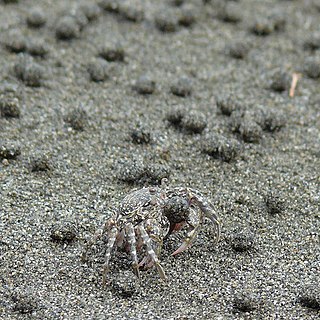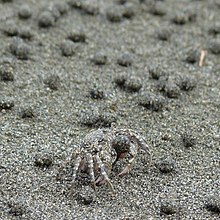
Lobsters are a family of large marine crustaceans.

The Caridea, commonly known as caridean shrimp or true shrimp, are an infraorder of shrimp within the order Decapoda. This infraorder contain all species of true shrimp. They are found widely around the world in both fresh and salt water. Many other animals with similar names – such as ghost shrimps, mud shrimps, and boxer shrimps – are not true shrimps, but many have evolved features similar to true shrimps.

Dendrobranchiata is a suborder of decapods, commonly known as prawns. There are 540 extant species in seven families, and a fossil record extending back to the Devonian. They differ from related animals, such as Caridea and Stenopodidea, by the branching form of the gills and by the fact that they do not brood their eggs, but release them directly into the water. They may reach a length of over 330 millimetres (13 in) and a mass of 450 grams (1.0 lb), and are widely fished and farmed for human consumption.

Crabs are decapod crustaceans of the infraorder Brachyura, which typically have a very short projecting "tail" (abdomen), usually hidden entirely under the thorax. They live in all the world's oceans, in fresh water, and on land, are generally covered with a thick exoskeleton, and have a single pair of pincers. Many other animals with similar names – such as hermit crabs, king crabs, porcelain crabs, horseshoe crabs, stone crabs, and crab lice – are not true crabs, but many have evolved features similar to true crabs through a process known as carcinisation.

Emerita is a small genus of decapod crustaceans, known as mole crabs, sand crabs, sand bugs, or sand fleas. These small animals burrow in the sand in the swash zone and use their antennae for filter feeding.

A fiddler crab, sometimes known as a calling crab, may be any of more than one hundred species of semiterrestrial marine crabs in the family Ocypodidae. A smaller number of ghost crab and mangrove crab species are also found in the family Ocypodidae. This entire group is composed of small crabs, the largest being slightly over two inches (5 cm) across. Fiddler crabs are found along sea beaches and brackish intertidal mud flats, lagoons and swamps. Fiddler crabs are most well known for their sexually dimorphic claws; the males' major claw is much larger than the minor claw, while the females' claws are both the same size.

King crabs are a taxon of crab-like decapod crustaceans chiefly found in cold seas. Because of their large size and the taste of their meat, many species are widely caught and sold as food, the most common being the red king crab.

Mictyris is a genus of brightly coloured crabs, placed in its own taxonomical family, the Mictyridae. It inhabits the central Indo-West Pacific region. These crabs congregate on mud flats or beaches in groups of a few thousand, and filter sand or mud for microscopic organisms. They congregate during low tide, and bury themselves in the sand during high tide or whenever they are threatened. This is done in wet sand, and they dig in a corkscrew pattern, leaving many small round pellets of sand behind them.

Terrestrial animals are animals that live predominantly or entirely on land, as compared with aquatic animals, which live predominantly or entirely in the water, or amphibians, which rely on a combination of aquatic and terrestrial habitats. Terrestrial invertebrates include ants, flies, crickets, grasshoppers and spiders.

The coconut crab is a species of terrestrial hermit crab, also known as the robber crab or palm thief. It is the largest terrestrial arthropod in the world, with a weight up to 4.1 kg (9.0 lb). It can grow to up to 1 m in length from each tip to tip of the leg. It is found on islands across the Indian Ocean, and parts of the Pacific Ocean as far east as the Gambier Islands and Pitcairn Islands, similar to the distribution of the coconut palm; it has been extirpated from most areas with a significant human population, including mainland Australia and Madagascar. Coconut crabs also live off the coast of Africa near Zanzibar.

Dromia personata, also known as the sponge crab or sleepy crab, is a species of crab found in the North Sea, the Mediterranean Sea, and connecting parts of the northeastern Atlantic Ocean. Like most other epibenthic crustaceans, the biomass of this species is especially dense in the Mediterranean continental shelf. It mainly resides from the lower shore to a depth of 50 meters (164 ft), often in caves. Occasionally, they are found living in depths as low as 110 meters (360 ft). They serve as prey for octopus, starfish, and other fish. Their last two pairs of legs are positioned dorsally, and are used to hold a sponge in place as camouflage.

The Dotillidae are a family of crabs with 59 species, nearly half of which are in the genus Ilyoplax. The two genera Scopimera and Dotilla are collectively the sand bubbler crabs, which leave conspicuous collections of sand pellets on sandy beaches across the tropical and subtropical Indo-Pacific.

Mictyris longicarpus, the light-blue soldier crab, is a species of crab that lives on sandy beaches from the Bay of Bengal to Australia; with other members of the genus Mictyris, it is "one of the most loved crabs in Australia". Adults are 25 mm (1 in) across, white, with blue on their backs, and hold their claws vertically. They feed on detritus in the sand, leaving rounded pellets of discarded sand behind them. The males may form into large "armies" which traverse the beach at low tide, before the crabs dig into the sand to wait for the next low tide.

Ocypode gaudichaudii, also known as the painted ghost crab or cart driver crab, is a species of crab found on Pacific beaches from El Salvador to Chile as well as on the Galápagos Islands. The species was first described by Henri Milne-Edwards and Hippolyte Lucas in 1843.
Mictyris guinotae is a species of soldier crab of genus Mictyris, endemic to the Ryukyu Islands of Japan. They were named after Danièle Guinot, a professor at the Muséum national d'histoire naturelle in France, and were first treated as a separate species in a tribute volume to Guinot.

Ocypode africana, commonly known as the African ghost crab, is a species of ghost crabs native to the eastern Atlantic coast of western Africa, from Mauritania to Namibia. They are medium-sized ghost crabs reaching carapace width of 3.4 cm (1.3 in). They can vary in coloration from pinkish to dark grey. They are one of only two ghost crab species found in the eastern Atlantic. However, African ghost crabs can easily be distinguished from tufted ghost crabs by the absence of long tufts of hair on the tip of their eyestalks.

Ocypode convexa, commonly known as the golden ghost crab, or alternatively the western ghost crab or yellow ghost crab, is a species of ghost crabs endemic to the coast of Western Australia, from Broome to Perth. They are relatively large ghost crabs, with a carapace growing up to 45 mm (1.8 in) long and 52 mm (2.0 in) wide. They are easily recognisable by their golden yellow colouration. Like other ghost crabs they have box-like bodies with unequally sized claws. They also have large eyestalks with the cornea occupying most of the bottom part.

Dotilla myctiroides is a species of sand bubbler crab found on tropical shores and mud-flats of India, Thailand, Malaysia, Indonesia, Singapore and Sri Lanka. They breed throughout the year but activity peaks during the monsoons. This species builds a burrow, called an "igloo", in unstable sand as well as in well-drained and firm sand. In building the igloo, the crab excavates sand and forms it into spherical pellets. These pellets are used to form a circular wall and roof in the burrow. The resulting structure holds a small amount of air in addition to the crab itself.

Leptuca thayeri, known generally as the Atlantic mangrove fiddler crab or mangrove fiddler, is a species of true crab in the family Ocypodidae. It is distributed all across the Western Atlantic.


















